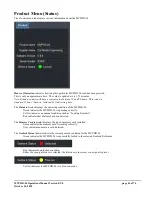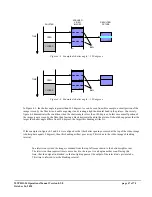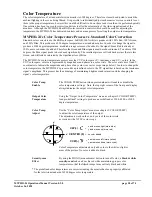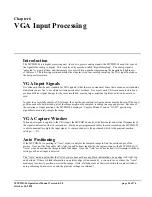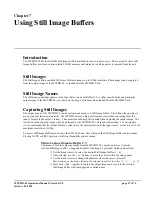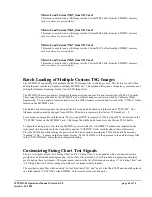
MVPHD-24 Operations Manual Version 0.9.0 page 50 of 74
October 26, 2020
Color Temperature
The color temperature of a standard television monitor is 6500 degrees. Therefore it must be adjusted to match the
ambient lighting in the scene being filmed. It is possible to individually adjust each monitor’s screen controls to set
them to the proper temperature; however this would be difficult to do on the set and it could not be performed quickly.
One solution has been to use color correction devices to alter the colorimetry of the video signal instead of the
monitors. Although the MVPHD-24 has RGB color correction controls which could be used for adjusting the
temperature, the MVPHD-24 has dedicated controls and a unique process for setting the output color temperature.
MVPHD-24’s Color Temperature Process vs. Standard Color Correction
Standard color correctors use the RGB color space. In RGB, 100% white is produce with 100% Red, 100% Green,
and 100% Blue. This produces a 6500 degree temperature on a standard monitor. In order to change the signal to
produce a 3200 degree temperature, a reddish-orange color must be added to the signal. Since Red is already at
100%, more red cannot be added. Therefore the Green and Blue signals must be reduced instead. To achieve 3200
degrees, the Blue signal needs to be reduced significantly. The resultant picture will look darker since there is less
Green, and will look desaturated by the significant loss of Blue.
The MVPHD-24’s color temperature process uses the YUV color space (Y = luminance, and UV = color). In the
YUV color space, colors are represented by magnitudes and phases in a color circle. The color circle uses X and Y
coordinates to indicate the magnitude and phase of any color (see vector scope image below). In order to change the
color temperature, the MVPHD-24’s process adds a predefined color to the UV signal that is based on the luminance
signal’s amplitude. This process has the advantage of maintaining brightness and saturation while changing the
signal’s color temperature.
Color Temp Enable
Color Temp
The COLOR TEMP button (when pressed alone) will enable or disable the
Enable
color temperature settings. Note: the top right corner of the front panel display
always indicates the output color temperature.
Output Color Temperature
Output Color
Using the “Output Color Temperature” menu (see chapter 3:COLOR TEMP),
Temperature
load pre-defined* settings to produce a user defined or 3200, 4800, or 5600
degree temperature.
Color Temp Adjust
Color Temp
Use the “Color Temp Adjust” menu (see chapter 3:COLOR TEMP)
Adjust
to adjust the color temperature of the output.
The adjustments work on the x and y axis of the color circle
as viewed with a NTSC vector scope.
x
y
Yellow
Green
Cyan
Blue
Red
Magenta
CW (+)
=
x axis moves right (more blue)
y axis moves up (more red)
CCW (-)
=
x axis moves left (more yellow)
y axis moves down (more cyan)
CENTER (0)
= no color added
Color Temperature adjustments only add color to the white or lighter
areas of the picture. No color is added to black.
Security-cam Effect
Security-cam
By using the MONO (monochrome) button to turn off color, a
black & white
Effect
security-cam
look can be achieved while maintaining proper color
temperature so that the filmed image turns out truly black and white.
* The predefined color temperatures are correct assuming the monitor has been properly calibrated
for the television standard of 6500 degree color temperature.









